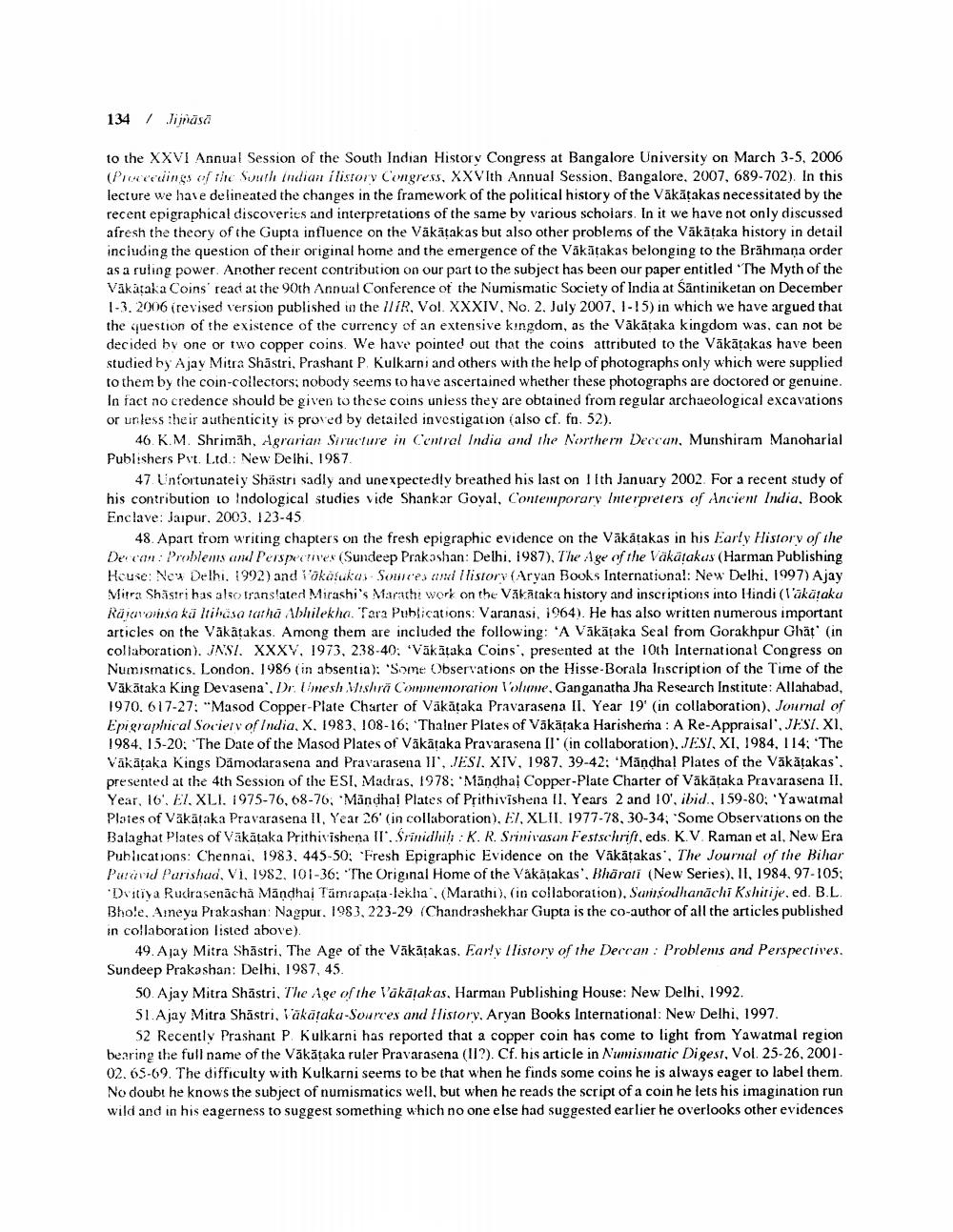________________
134
/
Jimāsā
to the XXVI Annual Session of the South Indian History Congress at Bangalore University on March 3-5, 2006 (Proceedings of the South Indian i listory Congress, XXVIth Annual Session, Bangalore, 2007, 689-702). In this lecture we have delineated the changes in the framework of the political history of the Väkätakas necessitated by the recent epigraphical discoveries and interpretations of the same by various scholars. In it we have not only discussed afresh the theory of the Gupta influence on the Vākātakas but also other problems of the Väkätaka history in detail including the question of their original home and the emergence of the Vákātakas belonging to the Brāhmaṇa order as a ruling power. Another recent contribution on our part to the subject has been our paper entitled "The Myth of the Vakataka Coins' read at the 90th Annual Conference of the Numismatic Society of India at Santiniketan on December 1-3. 2006 irevised version published in the ILIR, Vol. XXXIV, No. 2, July 2007, 1-15) in which we have argued that the question of the existence of the currency of an extensive kingdom, as the Vākátaka kingdom was, can not be decided by one or two copper coins. We have pointed out that the coins attributed to the Vākātakas have been studied by Ajay Mitra Shastri, Prashant P. Kulkarni and others with the help of photographs only which were supplied to them by the coin-collectors: nobody seems to have ascertained whether these photographs are doctored or genuine. In fact no credence should be given to these coins unless they are obtained from regular archaeological excavations or unless their authenticity is proved by detailed investigation (also cf. fr. 52).
46.K.M. Shrimah, Agrarian Siructure in Central India and the Northern Deccan, Munshiram Manoharial Publishers Pvt. Ltd.: New Delhi, 1987
47. Unfortunately Shastri sadly and unexpectedly breathed his last on IIth January 2002. For a recent study of his contribution to Indological studies vide Shankar Goval, Contemporary Interpreters of Ancient India, Book Enclave: Jaipur. 2003, 123-45
48. Apart from writing chapters on the fresh epigraphic evidence on the Väkatakas in his Early History of the De car: Problems and Perspectives (Sundeep Prakoshan: Delhi, 1987), The Age of the Väkātakus (Harman Publishing House: Neu Delhi. 1992) and I'ökolukus Sources anillistory (Aryan Books International: New Delhi, 1997) Ajay Mitra Shastri has also translated Mirashi's Marathi work on the Vākätaka history and inscriptions into Hindi (lakätaku Rüicrovisa kā lihasa tatha Abhilekha, Tara Publications: Varanasi, 1964). He has also written numerous important articles on the Vakatakas. Among them are included the following: 'A Vákātaka Seal from Gorakhpur Ghat' (in collaboration). JASI. XXXV. 1973, 238-40: Vākāțaka Coins, presented at the 10th International Congress on Numismatics. London, 1986 (in absentia); 'Some Observations on the Hisse-Borala Inscription of the Time of the Vakätaka King Devasena', Dr thmesh Mishra Commemoration Volume, Ganganatha Jha Research Institute: Allahabad, 1970. 617-27: "Masod Copper-Plate Charter of Väkātaka Pravarasena II, Year 19' (in collaboration). Journal of Epigraphical Societv of India, X. 1983, 108-16; "Thalner Plates of Vākātaka Harishema: A Re-Appraisal', JESI. XI. 1984, 15-20; "The Date of the Masod Plates of Vākātaka Pravarasena Il' (in collaboration). JEST, XI, 1984, 114; The Vākātaka Kings Damodara sena and Pravarasena II', JESI. XIV, 1987. 39-42: Māndhal Plates of the Vākātakas'. presented at the 4th Session of the ESI, Madras, 1978: Māndhai Copper-Plate Charter of Vākātaka Pravarasena II. Year, 16. El. XLI. 1975-76, 68-76; Māndhal Plates of Prithivishena Il. Years 2 and 10', ibid., 159-80; 'Yawatmal Plates of Vākātaka Pravarasena ll, Year 26' (in collaboration), EI, XLII. 1977-78, 30-34; Some Observations on the Balaghat Plates of Vākātaka Prithivishena II. Srinidhih :K. R. Srinivasan Festschrift, eds. K.V. Raman et al, New Era Publications: Chennai, 1983, 445-50; Fresh Epigraphic Evidence on the Vākāțakas, The Journal of the Bihar Parud Parishad, Vi, 1982, 101-36: "The Original Home of the Vakatakas'. Bhärali (New Series), II, 1984, 97-105; *Dvitiya Rudrasenacha Mändhai Tamrapata-lekha. (Marathi), (in collaboration), Sarisodhanachi Kshitije, ed. B.L. Bhole, Aineya Prakashan: Nagpur. 1983, 223-29 (Chandrashekhar Gupta is the co-author of all the articles published in collaboration listed above).
49. Ajay Mitra Shastri, The Age of the Vākātakas, Early Ilistory of the Deccan : Problems and Perspectives. Sundeep Prakəshan: Delhi, 1987, 45.
50. Ajay Mitra Shastri, The Age of the Vākāļakas, Harman Publishing House: New Delhi, 1992. 51. Ajay Mitra Shăstri, Vakataka-Sources and History, Aryan Books International: New Delhi, 1997.
52 Recently Prashant P. Kulkarni has reported that a copper coin has come to light from Yawatmal region bearing the full name of the Vākätaka ruler Pravarasena (II?). Cf. his article in Numismatic Digest, Vol. 25-26, 200102.65-69. The difficulty with Kulkarni seems to be that when he finds some coins he is always eager to label them. No doubt he knows the subject of numismatics well, but when he reads the script of a coin he lets his imagination run wild and in his eagerness to suggest something which no one else had suggested earlier he overlooks other evidences




